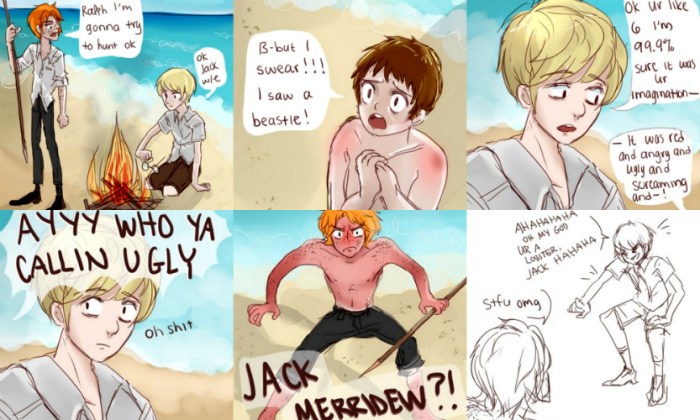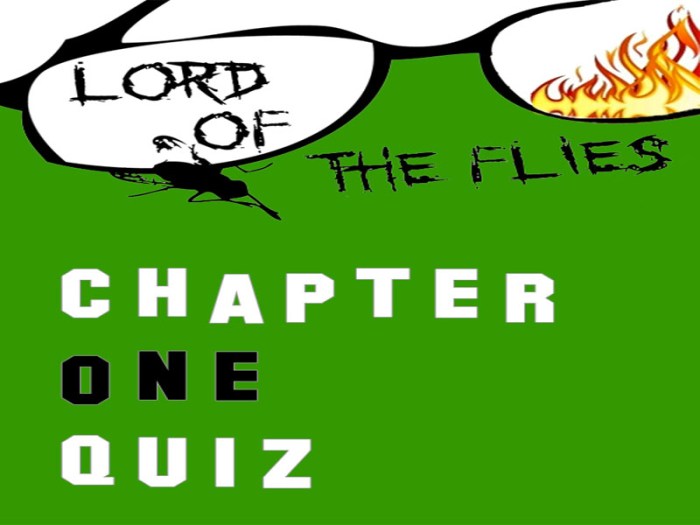Chapter 1 Lord of the Flies Quiz embarks on a captivating journey into the heart of William Golding’s literary masterpiece. This comprehensive quiz delves into the intricate tapestry of characters, themes, and symbolism that lay the foundation for the novel’s exploration of the delicate balance between civilization and savagery.
Prepare to engage in a thought-provoking examination of the initial events and characters introduced in Chapter 1, as well as their profound impact on the unfolding narrative. Through insightful questions and expert analysis, this quiz invites you to delve into the depths of Golding’s literary genius, unraveling the complexities of human nature and the enduring power of his timeless work.
Chapter Overview
The initial chapter of William Golding’s “Lord of the Flies” sets the stage for the novel’s central themes and introduces its primary characters. A group of young British boys find themselves stranded on a deserted island after their plane crashes during a wartime evacuation.
Among them are Ralph, the elected leader; Piggy, an intelligent and asthmatic boy; and Jack, the head of the choir and a natural leader with a penchant for violence.
The discovery of a conch shell by Ralph becomes a pivotal moment. The conch serves as a symbol of authority and order, and its sound summons the boys to meetings. The establishment of rules and the division of labor among the boys are early attempts to create a civilized society on the island.
The Conch Shell
The conch shell holds immense significance in the novel. Its distinct sound serves as a rallying point for the boys, calling them together for important discussions and decision-making. As a symbol of authority, the conch represents the fragile order and civilization that the boys strive to maintain.
However, as the story progresses, the conch’s influence wanes as the boys succumb to their primal instincts.
Character Analysis
The initial introduction to Ralph, Piggy, and Jack in Lord of the Flies establishes their distinct personalities and motivations, which shape their interactions and the development of the story.
Ralph emerges as a natural leader, possessing charisma, athleticism, and a sense of responsibility. He is elected chief by the boys and attempts to maintain order and reason on the island.
Piggy
Piggy, the intellectual of the group, is characterized by his intelligence, asthma, and physical weakness. Despite his physical limitations, Piggy’s intelligence and common sense make him a valuable asset to the group. However, his logical and pragmatic nature often clashes with the impulsive and emotional tendencies of the other boys.
Jack
Jack, the leader of the hunters, represents the primal and savage instincts of the boys. He is skilled, strong, and ambitious, but also ruthless and power-hungry. Jack’s desire for control and his rejection of civilization lead him to challenge Ralph’s authority and ultimately plunge the island into chaos.
Setting and Symbolism
The physical environment of the island in Lord of the Fliesplays a crucial role in shaping the boys’ behavior and foreshadowing the conflicts and themes that will unfold throughout the novel. The island is described as a tropical paradise, with lush vegetation, abundant fruit, and a pristine lagoon.
However, as the boys spend more time on the island, they begin to realize that it is also a place of danger and isolation.
The island’s beauty and abundance initially create a sense of freedom and excitement among the boys. They are free to explore the island, build shelters, and play games. However, as the boys become more accustomed to their surroundings, they begin to realize that the island is not as idyllic as it first appeared.
The vegetation is dense and difficult to navigate, the fruit is often sour or rotten, and the lagoon is home to dangerous creatures. The island’s beauty becomes a facade, hiding the harsh realities of survival.
Symbolism of the Island
The island itself is a symbol of the boys’ innocence and their potential for both good and evil. The boys initially see the island as a place of freedom and adventure, but they soon learn that it is also a place of danger and temptation.
The island’s beauty and abundance represent the boys’ potential for good, while its dangers and isolation represent their potential for evil.
Symbolism of the Lagoon
The lagoon is a symbol of the boys’ desire for order and civilization. The lagoon is a safe and平静的地方, where the boys can swim, play, and relax. However, the lagoon is also a place of temptation, as it is home to the island’s only source of fresh water.
The boys’ desire for the lagoon’s water represents their desire for order and civilization, but their temptation to drink the water represents their potential for savagery.
Symbolism of the Surrounding Forest
The surrounding forest is a symbol of the boys’ fear of the unknown and their own inner darkness. The forest is a dark and dangerous place, full of unknown creatures and hidden dangers. The boys’ fear of the forest represents their fear of the unknown and their own inner darkness.
The forest also represents the boys’ potential for savagery, as it is where the boys first begin to act like animals.
Themes and Motifs
Chapter 1 of “Lord of the Flies” introduces several central themes that will continue to develop throughout the novel. These themes include the conflict between civilization and savagery, the dynamics of power, and the loss of innocence.
Civilization vs. Savagery
The novel opens with a group of British boys stranded on a deserted island after their plane crashes. Initially, the boys attempt to maintain a semblance of civilization by electing a leader (Ralph) and establishing rules. However, as time goes on, the boys’ primal instincts begin to take over, and they gradually descend into savagery.
The conflict between civilization and savagery is illustrated by the characters of Ralph and Jack. Ralph represents the forces of civilization, while Jack represents the forces of savagery. Ralph believes in order and reason, while Jack believes in violence and power.
Power Dynamics
The novel also explores the dynamics of power. Ralph is initially elected leader of the boys, but Jack quickly challenges his authority. Jack is more charismatic and ruthless than Ralph, and he gradually gains the support of the other boys.
The power dynamics between Ralph and Jack are a microcosm of the power dynamics that exist in the world at large. Ralph represents the legitimate authority, while Jack represents the forces of tyranny and oppression.
Loss of Innocence
Finally, the novel explores the theme of the loss of innocence. The boys are initially innocent and carefree, but their experiences on the island gradually corrupt them.
The loss of innocence is symbolized by the death of Simon. Simon is a Christ-like figure who represents the best of humanity. His death at the hands of the other boys is a symbol of the loss of innocence and the triumph of savagery.
Foreshadowing and Suspense: Chapter 1 Lord Of The Flies Quiz

Chapter 1 of Lord of the Fliesintroduces several instances of foreshadowing that hint at future events and create suspense for the reader. These hints build anticipation and contribute to the novel’s overall narrative arc.
The Plane Crash
The opening scene of the chapter, which depicts the plane crash, foreshadows the chaos and danger that will follow. The pilot’s frantic warnings and the violent turbulence hint at the loss of adult authority and the vulnerability of the children.
The Beast, Chapter 1 lord of the flies quiz
The boys’ fear of a beast on the island, first mentioned by Piggy, foreshadows the psychological struggles they will face. The beast represents the primal instincts and violence that lurk within them, which will ultimately lead to their downfall.
The Fire
The boys’ inability to control the fire they build foreshadows their failure to maintain order and civilization on the island. The fire, intended as a signal for rescue, instead becomes a symbol of destruction and chaos.
Jack’s Leadership
Jack’s assertive and aggressive behavior during the initial meeting foreshadows his eventual emergence as a ruthless leader. His desire for power and control hints at the conflict that will arise between him and Ralph, the more democratic leader.
The Coral Reef
The boys’ discovery of the coral reef, with its hidden pool and abundance of food, foreshadows the potential for a harmonious and idyllic existence on the island. However, the fact that the reef is hidden and inaccessible hints at the challenges and dangers that lie ahead.
Character Relationships

The initial relationships between the boys on the island are complex and dynamic, shaped by their individual personalities, social backgrounds, and the challenges they face in their new environment.
Initially, the boys form alliances based on their shared experiences and interests. Ralph, Piggy, and Simon, who were all part of the choir, establish a close friendship. They share a common desire for order and civilization and work together to create a functioning society on the island.
Conflicts and Rivalries
However, tensions soon arise between different groups of boys. Jack, the leader of the hunters, represents a more primal and savage side of human nature. He and his followers, including Roger and Maurice, prioritize hunting and survival over the rules and regulations established by Ralph and Piggy.
As the story progresses, these conflicts and rivalries intensify, leading to a breakdown in the group’s unity. The boys become increasingly divided, with Ralph and Jack emerging as the two main antagonists. Their contrasting leadership styles and values create a schism within the group that ultimately leads to tragedy.
Potential for Change and Evolution
Despite the initial alliances and conflicts, the relationships between the boys are not static. As they spend more time on the island, their relationships evolve and change. Some friendships strengthen, while others deteriorate. New alliances form, and old rivalries fade away.
The potential for change and evolution in these relationships is a significant aspect of the story. It suggests that human nature is not fixed and that even in the most extreme circumstances, people are capable of growth and redemption.
FAQ Compilation
What is the significance of the conch shell in Chapter 1?
The conch shell serves as a symbol of order and civilization among the boys, representing the hope for maintaining a semblance of democratic rule on the island.
How does Ralph’s leadership style differ from Jack’s?
Ralph’s leadership is characterized by reason and cooperation, while Jack’s is marked by authoritarianism and a focus on hunting and violence.
What does the island setting symbolize in Chapter 1?
The island represents a microcosm of society, where the boys’ initial innocence and optimism gradually give way to savagery and chaos.